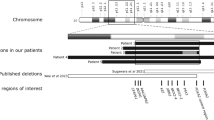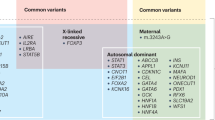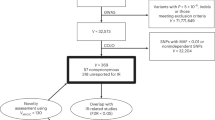Abstract
Familial hyperinsulinism (HI) is the most common cause of persistent neonatal hyperinsulinaemic hypoglycemia. Linkage analysis in 15 families (12 Ashkenazi Jewish, 2 consanguineous Arab, 1 non–Jewish Caucasian) mapped HI to chromosome 11p14–15.1 (lod score = 9.5, θ=0 at D11S921). Recombinants localized the disease locus to the 6.6 cM interval between D11S926 and D11S928. In Jewish families, association (p=0.003) with specific D11S921/D11S419 haplotypes suggested a founder effect. This locus, which is important for normal glucose–regulated insulin secretion, represents a candidate gene for studies of other diseases of β–cell dysfunction including non–insulin–dependent diabetes mellitus (NIDDM).
This is a preview of subscription content, access via your institution
Access options
Subscribe to this journal
Receive 12 print issues and online access
$209.00 per year
only $17.42 per issue
Buy this article
- Purchase on Springer Link
- Instant access to full article PDF
Prices may be subject to local taxes which are calculated during checkout
Similar content being viewed by others
References
Stanley, C.A. & Baker, L. Hyperinsulinism in infants and children: Diagnosis and therapy. Adv. Pediatr. 23, 315–355 (1976).
Landau, H. & Schiller, M. Persistent Hypoglycemia of Infancy and Childhood. in Pediatric Surgery of the Liver, Pancreas, and Spleen (eds. Schiller, M.) 187–201 (W.B. Saunders, Philadelphia, 1991).
Aynsley Green, A. et al. Nesidioblastosis of the pancreas: definition of the syndrome and the management of the severe neonatal hyperinsulinaemic hypoglycaemia. Arch. Dis. Child. 56, 496–508 (1981).
Kaiser, N. et al. Regulation of insulin release in persistent hyperinsulinaemic hypoglycaemia of infancy studied in long-term culture of pancreatic tissue. Diabetologia 33, 482–488 (1990).
Rahier, J. et al. The basic structural lesion of persistent neonatal hypoglycaemia with hyperinsulinism: deficiency of pancreatic D cells or hyperactivity of B cells? Diabetologia 26, 282–289 (1984).
Glaser, B., Hirsch, H.J. & Landau, H. Persistent hyperinsulinemic hypoglycemia of infancy: Long-term octreotide treatment without pancreatectomy. J. Pediatr. 123, 644–650 (1993).
Thornton, P.S., Alter, C.A., Levitt Katz, L.E., Baker, L. & Stanley, C.A. Short-and long-term use of octreotide in the treatment of congenital hyperinsulinism. J. Pediatr. 123, 637–643 (1993).
Glaser, B., Phillip, M., Carmi, R., Lieberman, E. & Landau, H. Persistent hyperinsulinemic hypoglycemia of infancy (“nesidioblastosis”): autosomal recessive inheritance in 7 pedigrees. Am. J. med. Genet. 37, 511–515 (1990).
Thornton, P.S. et al. Familial and sporadic hyperinsulinism: Histopathologic findings and segregation analysis support a single autosomal recessive disorder. J. Pediatr. 119, 721–724 (1991).
Bianchi, C., Corbella, E., Beccaria, L., Bolla, P. & Chiumello, G. A case of familial nesidioblastosis: prenatal diagnosis of foetal hyperinsulinism. Acta Paediatr. 81, 853–855 (1992).
Woolf, D.A., Leonard, J.V., Trembath, R.C., Pembrey, M.E. & Grant, D.B. Nesidioblastosis: evidence for autosomal recessive inheritance. Arch. Dis. Child. 66, 529–30 (1991).
Landau, H. et al. Persistent neonatal hypoglycemia due to hyperinsulinism: medical aspects. Pediatrics 70, 440–446 (1982).
Matsutani, A., Janssen, R., Donis-Keller, H. & Permutt, M.A. A polymorphic (CA)n repeat element maps the human glucokinase gene (GCK) to chromosome 7p. Genomics 12, 319–325 (1992).
Matsutani, A. et al. Mapping the human liver/islet glucose transporter (GLUT 2) gene within a genetic linkage map of chromosome 3q using a (Ca)n dinucleotide repeat polymorphism and characterization of the polymorphism in three racial groups. Genomics 13, 495–501 (1992).
Tanizawa, Y. et al. Human Glucagon-like peptide-1 Receptor Gene in Non-insulin Dependent Diabetes Mellitus: Identification and Use of Simple Sequence Repeat Polymorphism in Genetic Analysis. Diabetes (in the press).
Stoffel, M., Espinosa, R.3., Le Beau, M.M. & Bell, G.I. Human glucagon-like peptide-1 receptor gene. Localization to chromosome band 6p21 by fluorescence in situ hybridization and linkage of a highly polymorphic simple tandem repeat DNA polymorphism to other markers on chromosome 6. Diabetes 42, 1215–1218 (1993).
Ping, A.J. et al. Genetic linkage of Beckwith-Wiedemann Syndrome to 11p15. Am. J. hum. Genet. 44, 720–723 (1989).
Koufos, A. et al. Familial Wiedemann-Beckwith syndrome and a second Wilms tumor locus both map to 11 p15.5. Am. J. hum. Genet. 44, 711–719 (1989).
Weksberg, R., Ren Shen, D., Ling Fei, Y., Li Song, Q. & Squire, J. Disruption of insulin-like growth factor 2 imprinting in Beckwith-Wiedemann syndrome. Nature Genet. 5, 143–150 (1993).
Bruining, G.J. Recent advances in hyperinsulinism and the pathogenesis of diabetes mellitus. Curr. Opin. Pediatr. 2, 758–765 (1990).
Mathew, P.M. et al. Persistent neonatal hyperinsulinism. Clin. Pediatr. Phila. 27, 148–151 (1988).
Weksberg, R. et al. Molecular characterization of Beckwith-Wiedemann Syndrome (BWS) patients with partial duplication of chromosome 11p excludes the gene MYOD1 from the BWS region. Genomics 8, 693–698 (1990).
DeFronzo, R.A., Bonadonna, R.C. & Ferrannini, E. Pathogenesis of NIDDM. A balanced overview. Diabetes Care 15, 318–368 (1992).
O'Rahilly, S.O., Wainscoat, J.S. & Turner, R.C. Type2 (non-insulin-dependent) diabetes mellitus: new genetics for old nightmares. Diabetologia 31, 407–414 (1988).
Bell, G.I. et al. Gene for non-insulin-dependent diabetes mellitus (maturity-onset diabetes of the young subtype) is linked to DNA polymorphism on human chromosome 20q. Proc. natn. Acad. Sci. U.S.A. 88, 1484–1488 (1991).
Froguel, P. et al. Familial hyperglycemia due to mutations in glucokinase. New Engl. J. Med. 328, 697–702 (1993).
de Vijlder, J.J. et al. Regional localization of the gene for thyroid peroxidase to human chromosome 2pter—p12. Cytogenet. Cell Genet. 47, 170–172 (1988).
Morris, C.M., Honeybone, L.M., Rollings, P.E. & Fitzgerald, P.H. Localization of the SRC oncogene to chromosome band 20q11.2 and loss of this gene with deletion (20q) in two leukemic patients. Blood 74, 1768–1773 (1989).
Tanigami, A. et al. Mapping of 262 DNA markers into 24 intervals on human chromosome 11. Am. J. hum. Genet. 50, 56–64 (1992).
Gaensler, K.M., Burmeister, M., Brownstein, B.H., Taillon-Miller, P. & Myers, R.M. Physical mapping of yeast artificial chromosomes containing sequences from the human beta-globulin gene region. Genomics 10, 976–984 (1991).
Weber, J.L., Kwitek, A.E. & May, P.E. Dinucleotide repeat polymorphisms at the D11S419 and CD3D loci. Nucl. Acids Res. 18, 4036 (1990).
Keith, T.P. et al. A comprehensive genetic linkage map of the human genome. Science 258, 67–86 (1992).
Hudson, T.J. et al. Isolation and chromosomal assignment of 100 highly informative human simple sequence repeat polymorphism. Genomics 13, 622–629 (1992).
Litt, M. et al. A microsatellite-based index map of human chromosome 11. Hum. molec. Genet. 2, 909–913 (1993).
Author information
Authors and Affiliations
Rights and permissions
About this article
Cite this article
Glaser, B., Chiu, K., Anker, R. et al. Familial hyperinsulinism maps to chromosome 11p14–15.1, 30 cM centromeric to the insulin gene. Nat Genet 7, 185–188 (1994). https://doi.org/10.1038/ng0694-185
Received:
Accepted:
Issue Date:
DOI: https://doi.org/10.1038/ng0694-185
This article is cited by
-
Hyperinsulinism in mice with heterozygous loss of KATP channels
Diabetologia (2006)
-
Pancreatic regeneration after near-total pancreatectomy in children with nesidioblastosis
Pediatric Radiology (2005)
-
Focal and diffuse beta cell changes in persistent hyperinsulinemic hypoglycemia of infancy
Endocrine Pathology (1999)
-
Linkage-disequilibrium mapping without genotyping
Nature Genetics (1998)
-
Chromosomal mapping of genetic loci associated with non-insulin dependent diabetes in the GK rat
Nature Genetics (1996)



